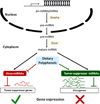Cancer chemoprevention by dietary polyphenols: promising role for epigenetics
- PMID: 20599773
- PMCID: PMC2974019
- DOI: 10.1016/j.bcp.2010.06.036
Cancer chemoprevention by dietary polyphenols: promising role for epigenetics
Abstract
Epigenetics refers to heritable changes that are not encoded in the DNA sequence itself, but play an important role in the control of gene expression. In mammals, epigenetic mechanisms include changes in DNA methylation, histone modifications and non-coding RNAs. Although epigenetic changes are heritable in somatic cells, these modifications are also potentially reversible, which makes them attractive and promising avenues for tailoring cancer preventive and therapeutic strategies. Burgeoning evidence in the last decade has provided unprecedented clues that diet and environmental factors directly influence epigenetic mechanisms in humans. Dietary polyphenols from green tea, turmeric, soybeans, broccoli and others have shown to possess multiple cell-regulatory activities within cancer cells. More recently, we have begun to understand that some of the dietary polyphenols may exert their chemopreventive effects in part by modulating various components of the epigenetic machinery in humans. In this article, we first discuss the contribution of diet and environmental factors on epigenetic alterations; subsequently, we provide a comprehensive review of literature on the role of various dietary polyphenols. In particular, we summarize the current knowledge on a large number of dietary agents and their effects on DNA methylation, histone modifications and regulation of expression of the non-coding miRNAs in various in vitro and in vivo models. We emphasize how increased understanding of the chemopreventive effects of dietary polyphenols on specific epigenetic alterations may provide unique and yet unexplored novel and highly effective chemopreventive strategies for reducing the health burden of cancer and other diseases in humans.
Copyright © 2010 Elsevier Inc. All rights reserved.
Conflict of interest statement
Figures




References
-
- Ellis L, Atadja PW, Johnstone RW. Epigenetics in cancer: targeting chromatin modifications. Mol Cancer Ther. 2009 Jun;8(6):1409–1420. - PubMed
-
- Esteller M. Epigenetics in cancer. N Engl J Med. 2008 Mar 13;358(11):1148–1159. - PubMed
-
- Dolinoy DC, Weidman JR, Jirtle RL. Epigenetic gene regulation: linking early developmental environment to adult disease. Reprod Toxicol. 2007 Apr;23(3):297–307. - PubMed
Publication types
MeSH terms
Substances
Grants and funding
LinkOut - more resources
Full Text Sources

